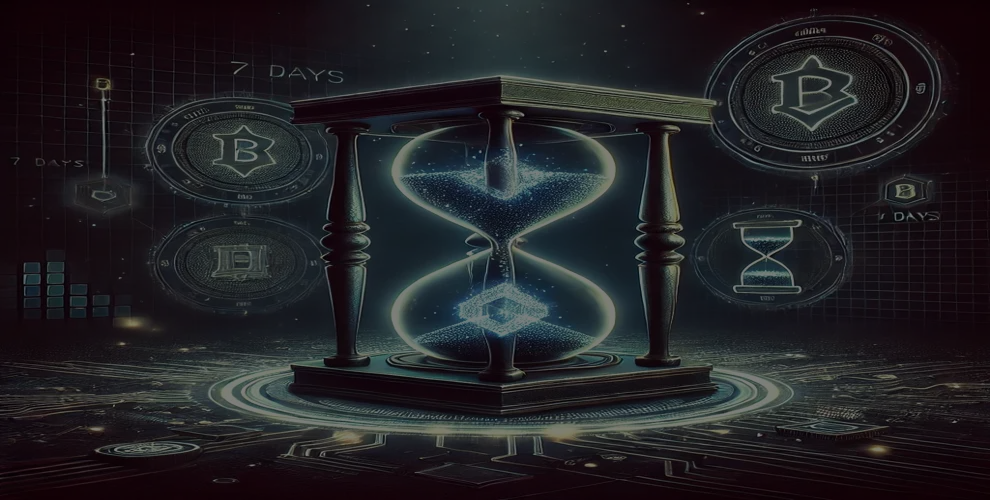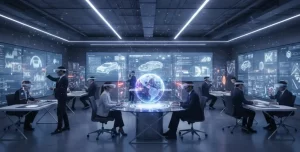
Master Blockchain in 7 Days: Start Here
Table of Contents
Introduction
Welcome to WikiGlitz!
We’ve brought you this amazing blog to guide you through mastering blockchain in just 7 days. Blockchain technology is rapidly transforming industries worldwide, making it crucial for tech enthusiasts and professionals to gain a solid understanding of this innovative field.
Whether you’re a complete beginner or looking to expand your knowledge, this guide will provide a structured and effective approach to learning blockchain quickly and efficiently.
Key Takeaways:
- A structured, step-by-step approach is essential for mastering blockchain in a week.
- Leveraging the right resources and tools can accelerate your learning process.
- Understanding the fundamentals deeply will set the foundation for advanced blockchain knowledge.
Day 1: Introduction to Blockchain Technology
Blockchain Basics for Beginners: What You Need to Know
A decentralised digital ledger called Blockchain keeps track of transactions made on a network of computers. Unlike traditional databases, blockchain is secure, transparent, and immutable.
A “block,” made up of all the transactions, is connected to a prior block to form a “chain.”
This structure ensures that once data is entered, it cannot be altered without altering all subsequent blocks—a feature that makes blockchain highly secure and reliable.
How to Get Started with Blockchain: Understanding the Core Concepts
On your first day, focus on grasping the fundamental concepts of blockchain. Start by familiarizing yourself with the key terms like blocks, nodes, miners, and consensus mechanisms.
Understanding these basics will provide a solid foundation for more complex topics. You can begin by exploring online resources, such as introductory articles and videos, to get a clear picture of how blockchain technology works.
Blockchain Concepts Explained: The Building Blocks of Blockchain
The core components of blockchain include:
- Decentralization: Unlike traditional systems where data is stored in a central location, blockchain distributes data across a network of nodes, enhancing security and transparency.
- Consensus Mechanisms: These are protocols used to validate transactions and add them to the blockchain.Two popular approaches are Proof of Stake (PoS) and Proof of Work (PoW).
- Smart Contracts: Contract terms are directly encoded into code in these self-executing contracts. This eliminates the need for middlemen by automating operations.
By the end of Day 1, you should have a solid understanding of what blockchain is and why it’s such a powerful technology.
Day 2: Exploring Blockchain Applications and Use Cases
Blockchain for Beginners: Real-World Applications
Now that you understand the basics, it’s time to explore how blockchain is used in the real world.
Blockchain’s impact extends beyond cryptocurrencies like Bitcoin; it’s transforming industries such as finance, healthcare, supply chain management, and more.
For instance, in the finance sector, blockchain enables faster and more secure transactions, while in supply chain management, it ensures transparency and traceability of goods.
How to Learn Blockchain Quickly by Studying Use Cases
A practical approach to learning blockchain quickly is by studying various use cases. This helps you understand how blockchain solves real-world problems. For example:
- Finance: Blockchain lessens the need for middlemen by enabling safe and transparent transactions.
- Healthcare: Blockchain ensures secure and interoperable patient records, improving healthcare outcomes.
- Supply Chain: Blockchain enhances transparency by providing an immutable record of the entire supply chain process.
By studying these examples, you can better understand how blockchain’s principles apply to various sectors, making your learning experience more practical and relevant.
Introduction to Blockchain Technology: Understanding Its Impact
Blockchain’s decentralized and secure nature makes it a game-changer in today’s digital landscape.
As you delve deeper into these applications, consider the broader implications of blockchain technology.
How is it changing the way businesses operate? What are the ethical considerations?
Understanding these aspects will help you appreciate the technology’s potential and its role in the future of various industries.
Day 3: Hands-On with Blockchain Development
Step-by-Step Blockchain Learning: Setting Up Your Development Environment
Day 3 is where the practical learning begins. To master blockchain development, you’ll need to set up a development environment.
Start by choosing a blockchain platform to work with, such as Ethereum, which is widely used for developing decentralized applications (dApps).
- Install Essential Tools: Begin by installing tools like Node.js, npm (Node Package Manager), and Git. These tools are necessary for managing your projects and dependencies.
- Set Up a Local Blockchain: Use tools like Ganache to create a personal blockchain for testing smart contracts. This local setup allows you to experiment without the risks associated with deploying on a live network.
- Choose an IDE: Integrated Development Environments (IDEs) like Visual Studio Code or Remix are excellent for writing and debugging your smart contracts.
Blockchain Skills for Beginners: Basic Programming and Development
To effectively develop on the blockchain, you’ll need to be familiar with certain programming languages.
For Ethereum, Solidity is the primary language used for writing smart contracts. Here’s how you can start:
- Learn Solidity: Begin with the basics of Solidity, focusing on syntax, data types, and functions. Resources like online tutorials, documentation, and coding exercises can be very helpful.
- Write Your First Smart Contract: Start small. Write a basic smart contract, such as a simple “Hello World” or a token contract. This hands-on experience will solidify your understanding of how blockchain development works.
How to Learn Blockchain Development: Writing Your First Smart Contract
Once your environment is set up, and you’re familiar with Solidity, it’s time to write and deploy your first smart contract. Here’s a step-by-step guide:
- Define the Contract: Start by defining what your contract will do. For example, create a contract that stores and retrieves information.
- Code the Contract: Use your IDE to write the code. Keep it simple at first, focusing on understanding how the contract operates.
- Test Locally: Use your local blockchain environment (e.g., Ganache) to test the contract. This will help you identify and fix any issues before deploying it on a live network.
- Deploy to a Test Network: Once you’re confident your contract works as expected, deploy it to a test network like Ropsten. This simulates the live environment without incurring real costs.
Day 4: Deep Dive into Blockchain Security and Consensus Mechanisms
Blockchain Crash Course: Security Fundamentals
Security is a critical aspect of blockchain development. On Day 4, focus on understanding the security features that make blockchain robust and the potential vulnerabilities that developers must address.
- Immutability and Decentralization: Understand how these core principles contribute to blockchain security. Immutability ensures that data, once written, cannot be changed, while decentralization reduces the risk of a single point of failure.
- Common Vulnerabilities: Learn about common security risks in blockchain, such as reentrancy attacks, integer overflows, and phishing. Understanding these vulnerabilities will help you write more secure smart contracts.
Blockchain Beginner’s Guide to Consensus Algorithms
Consensus algorithms are the protocols that ensure all nodes in a blockchain network agree on the state of the blockchain. Here’s what you need to know:
- Proof of Work (PoW): Used by Bitcoin, PoW requires miners to solve complex mathematical puzzles to validate transactions. It’s secure but energy-intensive.
- Proof of Stake (PoS): PoS, used by Ethereum 2.0, selects validators based on the number of coins they hold and are willing to “stake.” It’s more energy-efficient than PoW.
- Other Consensus Mechanisms: Explore other consensus algorithms like Delegated Proof of Stake (DPoS) and Practical Byzantine Fault Tolerance (PBFT), each with its own strengths and applications.
How to Master Blockchain in a Week: Understanding Security Challenges
Security challenges in blockchain go beyond smart contract vulnerabilities. As you continue your journey, it’s crucial to understand:
- 51% Attack: This occurs when a single entity controls more than 50% of the network’s mining power, potentially allowing them to manipulate transactions.
- Sybil Attacks: In a Sybil attack, a single adversary creates multiple fake identities to gain influence over the network. Consensus mechanisms like PoW and PoS are designed to mitigate these attacks.
- Social Engineering: This involves tricking individuals into compromising the security of the blockchain. Awareness and best practices are key defenses.
Day 5: Exploring Advanced Blockchain Concepts
Quick Blockchain Learning Guide: Diving Into Advanced Topics
By Day 5, you should have a solid grasp of the basics. Now, it’s time to dive into more advanced topics that will deepen your understanding and prepare you for real-world blockchain development.
- Layer 2 Solutions: Learn about technologies like Lightning Network and Plasma, which are designed to improve blockchain scalability by handling transactions off the main chain.
- Interoperability: Explore how different blockchains can interact and share data with each other.In this regard, initiatives like Polkadot and Cosmos are setting the standard.
- Smart Contract Auditing: Understand the importance of auditing smart contracts to ensure they are secure and function as intended. Tools like MythX and OpenZeppelin can help automate the auditing process.
Blockchain Learning Roadmap: What to Learn Beyond the Basics
As you continue to advance, focus on these areas to expand your expertise:
- Decentralized Finance (DeFi): DeFi applications are one of the fastest-growing sectors in blockchain. Learning about DeFi protocols and how to develop them will be invaluable.
- NFTs (Non-Fungible Tokens): Understand how NFTs work and their role in digital ownership and decentralized marketplaces.
- Governance: Explore how blockchain projects are governed through decentralized voting mechanisms and the role of token holders in decision-making.
How to Learn Blockchain Development: Exploring Scalability and Interoperability
Scalability and interoperability are two of the most pressing challenges in blockchain today. Here’s how you can approach them:
- Scalability Solutions: Study different approaches to improving blockchain scalability, including sharding and off-chain transactions. The goal of these methods is to boost transaction volume without sacrificing security.
- Interoperability Protocols: Learn about the protocols that enable different blockchains to communicate, such as cross-chain bridges and atomic swaps. Mastering these will allow you to develop applications that operate across multiple blockchain networks.
Day 6: Building and Deploying a Simple Blockchain Application
Blockchain Training for Beginners: Application Development
On Day 6, you’ll take what you’ve learned and apply it by building and deploying a simple blockchain application. This hands-on experience is crucial for solidifying your knowledge and gaining confidence in your skills.
- Choose a Project: Start with a straightforward project, such as a decentralized voting system or a simple token. The goal is to practice implementing blockchain concepts in a real-world scenario.
- Design Your Application: Plan out the architecture of your application. Identify the smart contracts you’ll need, how data will flow, and how users will interact with the system.
- Write the Code: Using the skills you’ve developed in Solidity or another blockchain programming language, begin coding your application. Focus on functionality first, then refine and optimize the code.
How to Learn Blockchain Quickly: From Theory to Practice
Turning theory into practice is the fastest way to learn. As you build your application, you’ll encounter challenges that will deepen your understanding of blockchain technology.
- Test Thoroughly: Before deploying your application, conduct extensive testing. Use your local blockchain environment to simulate different scenarios and ensure that your smart contracts work as intended.
- Iterate and Improve: Based on your tests, refine your code. Consider edge cases and potential vulnerabilities, and address them before moving forward.
Blockchain Crash Course: Deploying Your Application
Once you’re confident in your application, it’s time to deploy it to a live network. Here’s how:
- Select a Test Network: Before deploying on the mainnet, deploy your application on a test network like Ropsten or Rinkeby. This allows you to see how your application performs in a real-world environment without incurring costs.
- Deploy the Smart Contracts: Use tools like Remix or Truffle to deploy your smart contracts. To make sure everything proceeds as planned, keep a close eye on the procedure.
- Interact with the Application: Once deployed, interact with your application through a user interface or directly via smart contract calls. Test all features to confirm they are working as expected.
Day 7: Reviewing and Expanding Your Blockchain Knowledge
Best Resources to Learn Blockchain: Books, Courses, and Tutorials
Day 7 is all about reviewing what you’ve learned and planning your next steps.
Start by reflecting on your progress and identifying areas where you want to improve. Additionally, consider the best resources to continue your learning:
- Books: Titles like “Mastering Blockchain” by Imran Bashir and “Blockchain Basics” by Daniel Drescher provide in-depth knowledge that can further solidify your understanding.
- Online Courses: Platforms like Coursera, Udemy, and edX offer courses that cater to different skill levels, from beginner to advanced. Seek out classes that address both applied theory and real-world scenarios.
- Tutorials and Documentation: The official documentation for platforms like Ethereum and Hyperledger is invaluable. It’s essential to familiarize yourself with these resources, as they offer the most accurate and up-to-date information.
How to Master Blockchain in a Week: Recap and Next Steps
Reviewing your journey through the week, you’ve covered a lot of ground—from the basics of blockchain to developing and deploying your own application. Here’s a quick recap:
- Day 1-2: You learned the fundamentals of blockchain and explored its real-world applications.
- Day 3-4: You got hands-on with blockchain development, focusing on smart contracts and security.
- Day 5: You dived into advanced topics, such as scalability and interoperability.
- Day 6: You built and deployed a simple blockchain application.
As you move forward, focus on deepening your expertise in specific areas of interest, whether it’s DeFi, NFTs, or blockchain governance.
Start Learning Blockchain Today: Continuous Learning and Staying Updated
Blockchain technology is constantly evolving, and staying updated is crucial for long-term success. These are a few more methods to continue learning:
- Join Blockchain Communities: Engage with communities on platforms like Reddit, GitHub, and Stack Overflow. These communities are great for networking, finding mentors, and staying informed about the latest trends.
- Follow Industry Leaders: Keep up with thought leaders in the blockchain space through blogs, podcasts, and social media. They often share valuable insights and updates on emerging technologies.
- Try New Things and Develop: Learning is best accomplished by doing. Continue building projects, experimenting with new tools, and pushing the boundaries of what you can create with blockchain technology.
Conclusion
Thank you for joining us at WikiGlitz! We hope this guide has empowered you to master blockchain technology in just 7 days.
From understanding the basics to building and deploying your own application, this journey has equipped you with the skills and knowledge to navigate the exciting world of blockchain.
Remember, this is just the beginning. As blockchain continues to grow and evolve, staying curious and committed to learning will be key to your success.
Follow WikiGlitz for more insights into the world of blockchain and other cutting-edge technologies. Continue learning, investigating, and coming up with new ideas.
FAQs
How can I learn blockchain in 7 days?
You can learn blockchain in 7 days by following a structured, step-by-step approach that starts with understanding the basics and progresses to hands-on development and deployment of a simple application.
What are the best resources to start learning blockchain today?
Some of the best resources include books like “Mastering Blockchain,” online courses on platforms like Coursera and Udemy, and official documentation from blockchain platforms like Ethereum and Hyperledger.
Is it possible to master blockchain in a week?
While it’s challenging to become an expert in just a week, you can gain a solid foundation and hands-on experience with blockchain technology. Continuous learning and practice are key to mastering blockchain.
What basic concepts should I understand before diving into blockchain development?
Before diving into blockchain development, it’s crucial to understand core concepts like decentralization, consensus mechanisms, smart contracts, and blockchain security.
How do I keep improving my blockchain skills after this crash course?
To keep improving your skills, engage with blockchain communities, follow industry leaders, continue building projects, and stay updated with the latest trends and technologies in the blockchain space.
Want to keep up with our blog?
Our most valuable tips right inside your inbox, once per month.
Error: Contact form not found.
WikiGlitz Team
Welcome to WikiGlitz, your ultimate destination for tech insights and innovation. Our expert team is dedicated to delivering free resources and professional advice on various technology topics, including Artificial Intelligence, Cyber Security, Cloud Computing, and more. We strive to empower our readers with up-to-date information and practical guidance, ensuring you stay ahead in the rapidly evolving tech landscape. At WikiGlitz, we are passionate about making complex technology accessible to everyone. Our team of seasoned experts curates content that is both informative and engaging, helping you understand and leverage the latest tech trends. Whether you're a tech enthusiast or a professional, WikiGlitz is your go-to source for reliable, expert-driven content. Join us on this journey to explore and embrace the future of technology.





